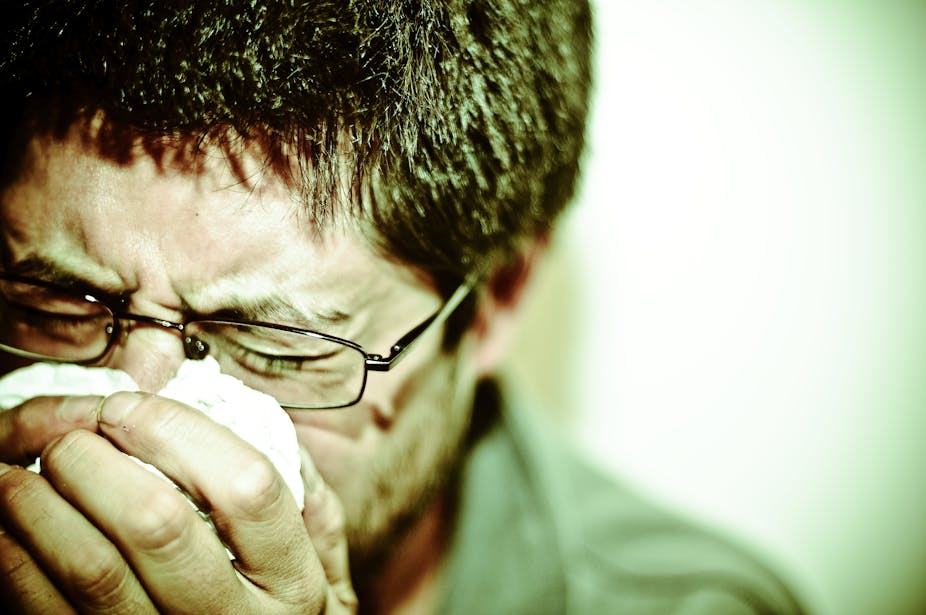Each year, different strains of influenza cause varying rates of illness throughout the community. So what strains are around this year and what kind of protection is offered by seasonal influenza vaccines? Robert Booy, Professor and Head of Clinical Research at the University of Sydney’s National Centre for Immunisation Research, explains.
Is this year’s flu season worse than usual?
Diagnostic laboratories in most states have reported higher rates of influenza notifications than the previous two years, so it’s the worst since 2009.
We suspect two reasons for this: first, with cooler and colder weather, people have spent more time indoors with others and have therefore been more likely to pass on infections.
Secondly, the main strain this winter is no longer H1, it’s H3. This strain has been quiet for a couple of years, meaning there’s likely to have been some fall off in background immunity from past infection. There’s also been some mutation – changes to the structure of the H3 – so the antibodies people have are less effective than they were.
Who is most at risk from this strain of influenza?
You’re most at risk of influenza when you’re very young or very old. Young children and babies are most likely to be hospitalised and people over the age of 75 are most likely to die from influenza. On average each year there are about 2,500 deaths from influenza in Australia, the large majority of them among the elderly.
On average, the H3 strain of flu is more severe than the other two strains (H1 or B) but all three can be deadly.
The H1 strain, which arrived as a new pandemic in 2009, preferentially affected people under the age of 60 because they didn’t have past exposure to H1 and had limited cross-protection from previous infection. So we had much more infection in younger people. But because their underlying health was better, the death rate was lower.
The H1 did, however, disproportionately affect some other groups such as pregnant women, in whom there were many severe infections resulting in intensive care and even the loss of pregnancies.
What strains of influenza does this year’s seasonal flu vaccination protect against?
The standard flu vaccine protects against three strains: two types of flu A (H1 and H3) and one type of flu B. The main strain causing disease this year is H3 and we have evidence from laboratory evaluations that the vaccine covers this year’s strain of H3. So we can expect that people who are vaccinated will be protected to at least the 75% level.
Year to year, the protection from a flu vaccine can vary from 50 and 90% but it usually settles out at around the 75% level.
How have attitudes to influenza changed since the swine flu pandemic?
People are definitely more aware of influenza and there’s no doubt that our testing facilities are more robust. Over the past five years there’s been a lot more testing for influenza in Australia, so the amount of disease detected can be higher for two reasons: an actual surge in the incidence and more frequent testing.
Who should get the flu vaccination – what do the government guidelines say?
The annual flu vaccine is recommended for anyone over the age of 65 or Indigenous Australians over the age of 50 and anyone above the age of six months who has a chronic medical condition which may include disorders of the heart, lung, kidney, liver, diabetes, immunosuppression and steroid treatment. The list also includes pregnant women.
Anyone who wants to be vaccinated can obtain this through their GP.
Less than half of young Australians with a high-risk condition have had either the flu vaccine or pneumonia vaccine. A higher vaccination rate would not only directly protect high-risk people, it would increase herd immunity.
What are the symptoms of influenza and when should you seek medical care?
Most people who get influenza actually get it as a relatively mild cold: perhaps 20% get it more severely, with a high fever, sore throat, muscle and headaches, and prostration (not being able to get out of bed). If you have those symptoms within 24 to 48 hours of falling ill your GP may prescribe an anti-viral therapy, but it only works early on in disease.
If you’ve been ill for longer and you have symptoms of an increased breathing rate, chest pain, cough and high fever, you may be developing pneumonia and could benefit from seeing the GP for antibiotic treatment.
Make sure you get plenty of rest and stay hydrated. Symptomatic treatments, such as over-the-counter products, may make you feel better but they’re not curative.
Further reading:
chainofprotection.org
See more Explainer articles on The Conversation.

